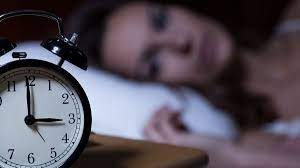Untangling the Problems with Insomnia and Its Treatments with Yoga
Insomnia, often known as sleeplessness, is a terrible disorder that affects countless people all over the globe. Insomnia, which is characterized by issues with getting to sleep, remaining asleep, or getting restorative sleep, may have significant negative implications on one’s physical and emotional health. Lack of sleep on a consistent basis may result in exhaustion, irritability, impaired cognitive performance, and a general decline in quality of life. Yoga, fortunately, provides a comprehensive strategy for treating insomnia, encouraging peace, relaxation, and better sleep patterns.
Sleeplessness, often known as insomnia, has become a widespread and frustrating problem amid the rush and bustle of contemporary life. It is defined by the difficulty to get asleep, remain asleep, or have restorative sleep, which may cause a variety of difficulties for one’s body, mind, and emotions. The normal sleep cycle may be thrown off, which can lead to exhaustion, irritation, decreased cognitive performance, and a general decline in quality of life. Insomnia may be brought on by things like stress, worry, lifestyle decisions, illnesses, and irregular sleeping patterns.
Yoga Pose to Fight Lack of Sleep:
The moderate inversion known as Viparita Karani (Legs Up the Wall Pose) includes reclining on your back with your legs stretched vertically up a wall. It promotes tranquility, lessens tension, and calms the neurological system. It encourages serenity and gets the body ready for sleep by promoting increased blood flow to the brain.
Balasana (Child’s Pose): This soothing position has you sat on your heels and folding forward with your arms out in front of you. Balasana helps to release stress and anxiety by relaxing the muscles along the back and gradually stretching the spine. Additionally helping to relax the mind is the pose’s encouragement of steady, rhythmic breathing.
Supta Baddha Konasana, also known as the “Reclining Bound Angle Pose,” has you lying on your back with your feet together and your knees bent at the sides. It relaxes you and releases stress by stretching your chest and hips. The parasympathetic nervous system, sometimes known as the “rest and digest” mode, is also stimulated, promoting restful sleep.
Savasana, also known as the corpse position, is often regarded as the last relaxation posture in a yoga session. It requires laying flat on your back with your arms and legs at your sides. This stance induces a deep sense of peace that calms the body and mind. It facilitates a calm transition into sleep by reducing tension and bringing about serenity.
Uttanasana (Standing Forward Bend): In this position, your upper body hangs freely while you stand and bend forward at the hips. Uttanasana helps the body get ready for relaxation by releasing back tension, stretching the hamstrings, and maybe acting as a calming antidote to worry.
How Yoga Helps to Fight Insomnia
Stress reduction: The parasympathetic nervous system is stimulated by yoga’s focus on relaxation and focused breathing. This activation promotes relaxation and lowers stress hormone levels, making it an effective remedy for stress-related insomnia.
Yoga exercises help to develop a greater awareness of the mind-body relationship. The flood of racing thoughts that often causes insomnia may be stilled by adopting mindfulness and centering oneself in the present moment.
Physical Relaxation: Yoga poses are intended to relieve physical stress, creating a cozy and accommodating atmosphere for the beginning of sleep.
nerve System Control: Yoga’s effects on the autonomic nerve system may assist control blood pressure, heart rate, and the body’s stress reaction, further fostering the circumstances necessary for sound sleep.
Yoga’s benefits and drawbacks for insomnia
Pros:
Approach that is non-invasive and drug-free: Yoga provides a holistic and natural way to treat insomnia, in contrast to pharmacological treatments.
Yoga has a strong focus on relaxation methods, which helps to lower stress and anxiety, two major causes of insomnia.
Enhanced Well-being: Yoga offers a wide range of advantages, including improved mental and physical health, in addition to sleep enhancement.
Improved Sleep Quality: People often notice better sleep quality and duration with regular practice.
Cons:
Realizing the advantages of yoga for insomnia requires consistent, persistent practice.
Limited Treatment for Severe Cases: Yoga may need to be supplemented with other treatments for those with severe or chronic insomnia in order to get the best outcomes.
Individual Variability: Depending on personal characteristics like the underlying cause of insomnia, yoga’s efficacy as a sleep aid may change.
Precautions:
Consultation with Healthcare Professionals: It is advised to speak with a healthcare professional before beginning a new yoga routine, particularly if you have any pre-existing medical concerns.
Instruction from certified teachers: To guarantee proper alignment and technique, beginners to yoga should practice under the direction of certified teachers.
Appropriate Timing: Prevent practicing yoga vigorously or energetically just before night as they may have an energizing impact that goes against the intention of relaxation.
Emphasis on Relaxation in the Evening: Use relaxing positions and breathing exercises in the evening to get your body and mind ready for bed.
Yoga offers a gentle and thorough way ahead in the fight against sleeplessness. An ongoing, committed practice has the power to create a calm sleep environment by restoring balance to the body and mind. It’s crucial to understand that even though yoga has many positive effects, finding better sleep may need persistence and time. However, the benefits go beyond the absence of sleep, enhancing life with serenity, fortitude, and a revitalized feeling of vigor.







